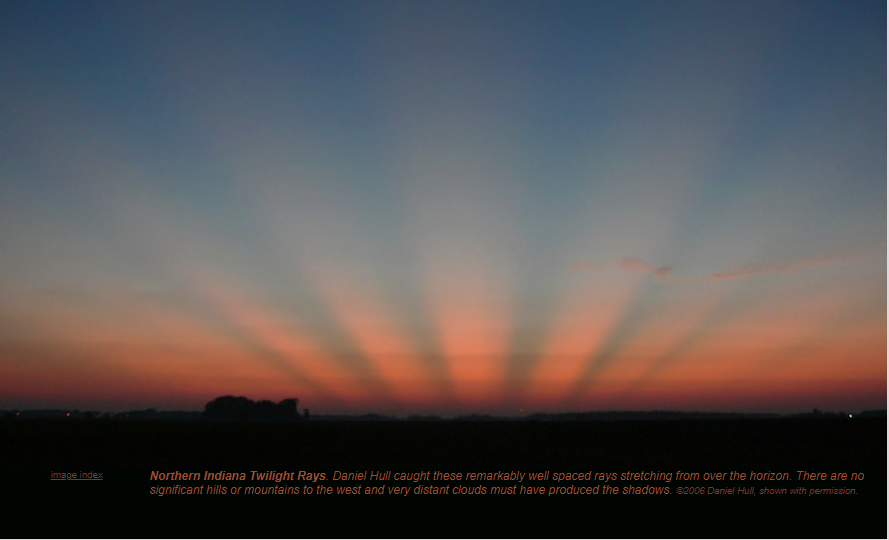Indiana over-the-horizon rays
Indiana Over-the-Horizon Rays: A Phenomenon of Illuminated Shadows
Have you ever witnessed a mesmerizing display of rays stretching across the sky, seemingly emanating from the horizon? These enchanting phenomena, known as over-the-horizon rays, can captivate anyone lucky enough to witness them. In this article, we will delve into the fascinating world of Indiana over-the-horizon rays, exploring their causes, characteristics, and the science behind their formation.
Over-the-horizon rays, also referred to as crepuscular rays, are beams of sunlight that appear to radiate from a single point on or below the horizon. While they are often associated with sunrise or sunset, they can also occur during other times of the day when atmospheric conditions are favorable. These rays result from the interaction of sunlight with various atmospheric particles, such as dust, water droplets, or ice crystals.
One of the key factors contributing to the formation of over-the-horizon rays is the presence of clouds or other objects that cast shadows in the atmosphere. When sunlight passes through gaps or breaks in these obstructions, it creates distinct beams of light that appear to converge at a single point on the horizon. The rays may appear parallel or diverging, depending on the angle at which they intersect the cloud or shadow-producing object.
In the case of Indiana over-the-horizon rays, the absence of significant hills or mountains to the west amplifies their visual impact. Without these obstructing landforms, the rays can extend uninterrupted across the sky, creating a breathtaking spectacle. The distant clouds act as the canvas upon which these ethereal shadows are projected, adding depth and dimension to the overall display.
The spacing between the rays in Indiana over-the-horizon ray formations is particularly noteworthy. Observers have often marveled at the remarkably even spacing between each beam of light. This regularity is a result of the way sunlight interacts with the cloud or shadow-producing object. As the light passes through the gaps or breaks, it undergoes diffraction, causing it to spread out and form a pattern of alternating bright and dark regions.
The precise spacing of the rays depends on various factors, including the size and shape of the particles in the atmosphere, the angle of the sunlight, and the distance between the observer and the cloud or shadow-producing object. These intricate interactions give rise to the visually striking arrangement of rays that grace the skies of Indiana.
To fully appreciate the beauty of over-the-horizon rays, it is essential to consider the broader context of atmospheric optics. These phenomena are part of a larger family of optical phenomena that occur due to the interaction of light with the atmosphere. Other members of this family include rainbows, halos, and sundogs, each possessing its own unique characteristics and formation mechanisms.
Understanding the science behind Indiana over-the-horizon rays allows us to appreciate their fleeting beauty even more. By unraveling the intricate interplay between sunlight, atmospheric particles, and shadows, we gain insight into the awe-inspiring spectacle that unfolds before our eyes. So, next time you find yourself in Indiana, keep an eye on the horizon and be prepared to witness the magical dance of over-the-horizon rays, a testament to the wonders of our atmospheric environment.

Northern Indiana Twilight Rays. Daniel Hull caught these remarkably well spaced rays stretching from over the horizon. There are no significant hills or mountains to the west and very distant clouds must have produced the shadows. ©2006 Daniel Hull, shown with permission.
Note: this article has been automatically converted from the old site and may not appear as intended. You can find the original article here.
Reference Atmospheric Optics
If you use any of the definitions, information, or data presented on Atmospheric Optics, please copy the link or reference below to properly credit us as the reference source. Thank you!
-
<a href="https://atoptics.co.uk/blog/indiana-over-the-horizon-rays/">Indiana over-the-horizon rays</a>
-
"Indiana over-the-horizon rays". Atmospheric Optics. Accessed on November 22, 2024. https://atoptics.co.uk/blog/indiana-over-the-horizon-rays/.
-
"Indiana over-the-horizon rays". Atmospheric Optics, https://atoptics.co.uk/blog/indiana-over-the-horizon-rays/. Accessed 22 November, 2024
-
Indiana over-the-horizon rays. Atmospheric Optics. Retrieved from https://atoptics.co.uk/blog/indiana-over-the-horizon-rays/.